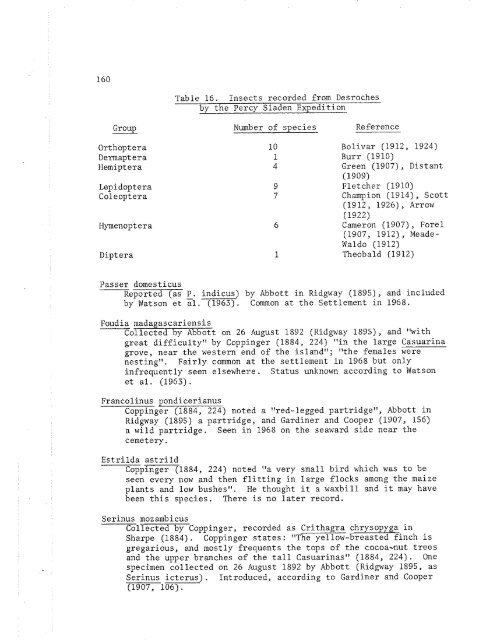ATOLL RESEARCH BULLETIN - Smithsonian Institution
ATOLL RESEARCH BULLETIN - Smithsonian Institution
ATOLL RESEARCH BULLETIN - Smithsonian Institution
Create successful ePaper yourself
Turn your PDF publications into a flip-book with our unique Google optimized e-Paper software.
Group<br />
-<br />
Orthoptera<br />
Dermaptera<br />
Hemiptera<br />
Lepidoptera<br />
Coleoptera<br />
Hymenoptera<br />
Diptera<br />
Table 16. Insects recorded from Desroches<br />
by the Percy Sladen Expedition<br />
Number of species<br />
10<br />
Reference<br />
Bolivar (1912, 1924)<br />
Burr (1910)<br />
Green (1907), Distant<br />
(1909)<br />
Fletcher (1910)<br />
Champion (1914), Scott<br />
(1912, 1926), Arrow<br />
(1922)<br />
Cameron (1907), Fore1<br />
(1907, 1912), Meade-<br />
Waldo (1912)<br />
Theobald (1912)<br />
Passer domesticus<br />
Reported (as P. indicus) by Abbott in Ridgway (1895), and included<br />
by Watson et zl. (1963). Common at the Settlement in 1968.<br />
Foudia madagascariensis<br />
Collected bv Abbott on 26 August - 1892 (Ridgway - . 1895), and "with<br />
great difficultyu by Coppinger (1884, 224) "in the large Casuarina<br />
grove, near the western end of the island"; "the females were<br />
nesting". Fairly common at the settlement in 1968 but only<br />
infrequently seen elsewhere. Status unknown according to Watson<br />
et al. (1963).<br />
Francolinus pondicerianus<br />
Coppinger (1884, 224) noted a "red-legged partridge", Abbott in<br />
Ridgway (1895) a partridge, and Gardiner and Cooper (1907, 156)<br />
a wild partridge. Seen in 1968 on the seaward side near the<br />
cemetery.<br />
Estrilda astrild<br />
Coppinger (1884, 224) noted "a very small bird which was to be<br />
seen every now and then flitting in large flocks among the maize<br />
plants and low bushes". He thought it a waxbill and it may have<br />
been this species. There is no later record.<br />
Serinus mozambicus<br />
Collected by Coppinger, recorded as Crithagra chrysopyga in<br />
Sharpe (1884). Coppinger states: "The yellow-breasted finch is<br />
gregarious, and mostly frequents the tops of the cocoa-nut trees<br />
and the upper branches of the tall Casuarinas" (1884, 224). One<br />
specimen collected on 26 August 1892 by Abbott (Ridgway 1895, as<br />
Serinus icterus). Introduced, according to Gardiner and Cooper<br />
(1907, 106).

















